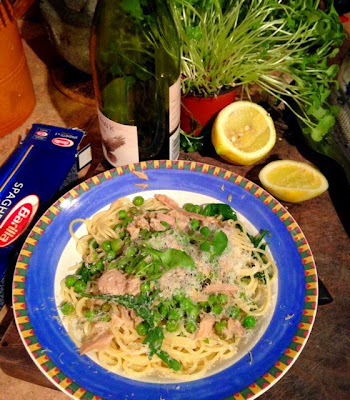It's become my standby dish and everyone loves it anyway - it's in the top ten requests from the family - and so quick and easy to make.
As spring has sprung in the garden I would rather be out there than slaving away in the kitchen and singing pasta has become my standard 'after a day in the garden' dish - satisfying, tasty and easy.
I first saw a variation of this, many years ago, in a Qantas inflight magazine by and Australian woman who ran a cooking school in Florence. This is what she served the arriving participants.
Like all simple dishes it's the quality of the ingredients that counts - which seems to have filtered down to my children as my son-in-law recently told me that he very quickly learned that only Sirena tuna and Barilla pasta should go in the trolley when he was doing the shopping. (He also now knows to buy local Australian extra virgin olive oil and check the date when it was pressed - fresh is best!). When I actually think about this it's mildly scary - have I become one of THOSE mothers and mother-in-laws?
Why singing pasta? Well, the flavours sing in your mouth; the zing of the lemon, sweetness of the peas, hit from the chilli and the rocket just cuts through the oily flavour with it's slight bitter edge.
What you will need for 4 people:
400 g can Sirena tuna in oil
500 g packet Barilla pasta No5 (or any other good quality dried pasta - don't use fresh for this)
1 cup frozen peas
Zest and juice of one fresh lemon
Fresh rocket, about a handful
White whine, about half a cup
Extra virgin olive oil, about a quarter of a cup
Parmesan cheese, finely grated
NOTE: This is one of those dishes that breaks the unwritten rule of no parmesan in pasta dishes with fish - see what you think?
Optional extras which I nearly always add; capers (I use pickled nasturtium seeds as a substitute) and a finely sliced red chilli - because I like chilli in everything.
Method:
1. Put on a large pot of salted water for the pasta. When it is boiling add the spaghetti and cook until al dente.
2. Put the tuna, zest of lemon (reserve the juice), wine and oil in a saucepan and bring to simmer - add capers and chilli at this stage too.
3. Add peas and heat through. DONE. Don't overcook.
4. Place the fresh rocket in the bottom of the colander and strain the pasta over it - the idea is to just wilt it. Flick the rocket through the spaghetti with a fork. Tip into a wide serving dish.
5. Adjust seasoning of tuna mix - may need extra salt - and pour over pasta and stir through.
6. Squeeze over lemon juice and top with finely grated parmesan cheese.
Am sure that this would taste even better on a balcony in Florence with a view over the Duomo but buon appetito anyway.






